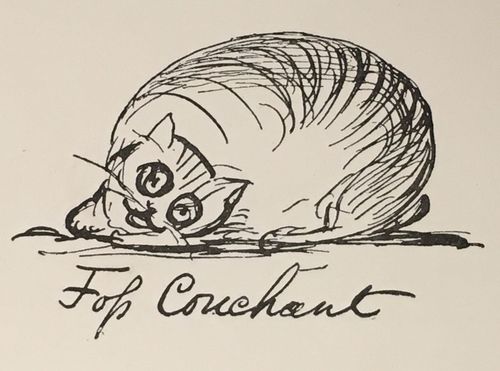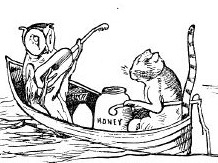Foss (cat) on:
[Wikipedia]
[Google]
[Amazon]
 Foss (c. 1873 – 26 November 1887), formally named Aderphos, was the pet cat of
Foss (c. 1873 – 26 November 1887), formally named Aderphos, was the pet cat of
 Foss is said to have been adopted by Edward Lear whilst a kitten in 1873, though Lear later claimed he was older. His full name was the Greek word Aderphos ( a variant of Adelphos, "brother"), but he was generally known by the shortened form of "Foss" or, particularly by Lear, "Old Foss". Foss was a
Foss is said to have been adopted by Edward Lear whilst a kitten in 1873, though Lear later claimed he was older. His full name was the Greek word Aderphos ( a variant of Adelphos, "brother"), but he was generally known by the shortened form of "Foss" or, particularly by Lear, "Old Foss". Foss was a
 Foss is said to have been the model for the pussycat in Lear's "
Foss is said to have been the model for the pussycat in Lear's "
 Foss was a key companion in Lear's later years, at a time when Lear was battling depression and loneliness. Foss died at Lear's Villa Tennyson in Sanremo in November 1887, just two months before Lear's own death. Foss has been reported as being 14, 16 or 17 years old at the time of his death, though Lear was convinced that he was much older and had the age of 31 years engraved on Foss' headstone. Some of Lear's pre-1872 drawings depict a cat very similar to Foss with a stumpy tail, tabby markings, and a portly appearance, and it is possible that Lear, knowingly or otherwise, conflated his imagined cat with the real Foss.
Foss was buried under his own headstone – with an epitaph composed by Lear – beneath a fig tree in the garden at Villa Tennyson. Foss' funeral is said to have had greater pomp and ceremony than Lear's own, which was poorly attended. Foss is mentioned in the song "Mr Lear" by British folk singer
Foss was a key companion in Lear's later years, at a time when Lear was battling depression and loneliness. Foss died at Lear's Villa Tennyson in Sanremo in November 1887, just two months before Lear's own death. Foss has been reported as being 14, 16 or 17 years old at the time of his death, though Lear was convinced that he was much older and had the age of 31 years engraved on Foss' headstone. Some of Lear's pre-1872 drawings depict a cat very similar to Foss with a stumpy tail, tabby markings, and a portly appearance, and it is possible that Lear, knowingly or otherwise, conflated his imagined cat with the real Foss.
Foss was buried under his own headstone – with an epitaph composed by Lear – beneath a fig tree in the garden at Villa Tennyson. Foss' funeral is said to have had greater pomp and ceremony than Lear's own, which was poorly attended. Foss is mentioned in the song "Mr Lear" by British folk singer
 Foss (c. 1873 – 26 November 1887), formally named Aderphos, was the pet cat of
Foss (c. 1873 – 26 November 1887), formally named Aderphos, was the pet cat of Edward Lear
Edward Lear (12 May 1812 – 29 January 1888) was an English artist, illustrator, musician, author and poet, who is known mostly for his literary nonsense in poetry and prose and especially his limerick (poetry), limericks, a form he popularised. ...
, the 19th-century author, illustrator, and poet. A "stumpy-tailed," "portly," and "unattractive" tabby cat
A tabby is any domestic cat (''Felis catus'') with a distinctive 'M'-shaped marking on its forehead; stripes by its eyes and across its cheeks, along its back, and around its legs and tail; and (differing by tabby type), characteristic striped, d ...
, he was a favourite of Lear's and played an important role as a companion in the poet's lonely later years. Foss is mentioned frequently in Lear's correspondence and appears in his illustrations and at least one poem. Foss is said to have been the inspiration for the pussycat in Lear's illustrations for his poem "The Owl and the Pussycat
"The Owl and the Pussy-cat" is a nonsense poem by Edward Lear, first published in 1870 in the American magazine '' Our Young Folks: an Illustrated Magazine for Boys and Girls'' and again the following year in Lear's own book ''Nonsense Songs, S ...
". The funeral that Lear provided for Foss, which included an epigraphed headstone, is said to have been more elaborate than Lear's own.
Description
 Foss is said to have been adopted by Edward Lear whilst a kitten in 1873, though Lear later claimed he was older. His full name was the Greek word Aderphos ( a variant of Adelphos, "brother"), but he was generally known by the shortened form of "Foss" or, particularly by Lear, "Old Foss". Foss was a
Foss is said to have been adopted by Edward Lear whilst a kitten in 1873, though Lear later claimed he was older. His full name was the Greek word Aderphos ( a variant of Adelphos, "brother"), but he was generally known by the shortened form of "Foss" or, particularly by Lear, "Old Foss". Foss was a tabby cat
A tabby is any domestic cat (''Felis catus'') with a distinctive 'M'-shaped marking on its forehead; stripes by its eyes and across its cheeks, along its back, and around its legs and tail; and (differing by tabby type), characteristic striped, d ...
described as "unattractive." His tail was cut short by Lear's servants to try to prevent him from wandering. No photographs survive of the cat, as he jumped out of Lear's arms on the only occasion when one was to be taken.
Lear grew fond of Foss and he was said to be his favourite animal. Foss was mentioned often in Lear's correspondence, to the extent that he was said to have been almost as famous as Lear at the time. He was said to roll on Lear's manuscripts to help dry the ink. Many accounts say that when Lear was planning his relocation to Sanremo
Sanremo (; lij, Sanrémmo(ro) or , ) or San Remo is a city and comune on the Mediterranean coast of Liguria, in northwestern Italy. Founded in Roman times, it has a population of 55,000, and is known as a tourist destination on the Italian Rivie ...
, he had his architect design his new villa on the same floor plan as his previous home to avoid confusing Foss. Despite this, on his first day in the villa Foss climbed into one of its chimneys.
Artistic influence
 Foss is said to have been the model for the pussycat in Lear's "
Foss is said to have been the model for the pussycat in Lear's "The Owl and the Pussy-Cat
"The Owl and the Pussy-cat" is a nonsense poem by Edward Lear, first published in 1870 in the American magazine '' Our Young Folks: an Illustrated Magazine for Boys and Girls'' and again the following year in Lear's own book ''Nonsense Songs, ...
" illustrations, though he chose to depict a full-length tail. Foss is also mentioned in Lear's poem "How Pleasant to Know Mr Lear":
There are also many drawings by Lear of Foss, including the two together and a series depicting Foss in supposed heraldic poses – these include couchant
In heraldry, the term attitude describes the ''position'' in which a figure (animal or human) is emblazoned as a charge, a supporter, or as a crest. The attitude of an heraldic figure always precedes any reference to the tincture of the figur ...
, passant, rampant
In heraldry, the term attitude describes the ''position'' in which a figure (animal or human) is emblazoned as a charge, a supporter, or as a crest. The attitude of an heraldic figure always precedes any reference to the tincture of the figure ...
, regardant, and the more fanciful "dansant" (dancing) and "a untin" (hunting). The ''New York Times'' said that Lear's illustrations of Foss were his best caricatures.
Death
 Foss was a key companion in Lear's later years, at a time when Lear was battling depression and loneliness. Foss died at Lear's Villa Tennyson in Sanremo in November 1887, just two months before Lear's own death. Foss has been reported as being 14, 16 or 17 years old at the time of his death, though Lear was convinced that he was much older and had the age of 31 years engraved on Foss' headstone. Some of Lear's pre-1872 drawings depict a cat very similar to Foss with a stumpy tail, tabby markings, and a portly appearance, and it is possible that Lear, knowingly or otherwise, conflated his imagined cat with the real Foss.
Foss was buried under his own headstone – with an epitaph composed by Lear – beneath a fig tree in the garden at Villa Tennyson. Foss' funeral is said to have had greater pomp and ceremony than Lear's own, which was poorly attended. Foss is mentioned in the song "Mr Lear" by British folk singer
Foss was a key companion in Lear's later years, at a time when Lear was battling depression and loneliness. Foss died at Lear's Villa Tennyson in Sanremo in November 1887, just two months before Lear's own death. Foss has been reported as being 14, 16 or 17 years old at the time of his death, though Lear was convinced that he was much older and had the age of 31 years engraved on Foss' headstone. Some of Lear's pre-1872 drawings depict a cat very similar to Foss with a stumpy tail, tabby markings, and a portly appearance, and it is possible that Lear, knowingly or otherwise, conflated his imagined cat with the real Foss.
Foss was buried under his own headstone – with an epitaph composed by Lear – beneath a fig tree in the garden at Villa Tennyson. Foss' funeral is said to have had greater pomp and ceremony than Lear's own, which was poorly attended. Foss is mentioned in the song "Mr Lear" by British folk singer Al Stewart
Alastair Ian Stewart (born 5 September 1945) is a Scottish born singer-songwriter and folk-rock musician who rose to prominence as part of the British folk revival in the 1960s and 1970s. He developed a unique style of combining folk-rock so ...
on his 2005 album '' A Beach Full of Shells''.
References
{{Reflist, 30em 1887 animal deaths Cats in art Cats in literature Individual cats Poetry by Edward Lear